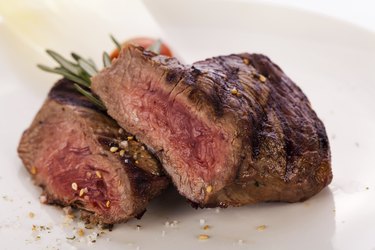
Today's cooks have rediscovered the old-fashioned technique of soaking meat in salted water, or brine, because it adds moisture and tenderizes tougher cuts. When the brine's salt gets replaced with baking soda, something remarkably different but equally tasty happens. Brine made with either salt or baking soda can tenderize meat, but the two ingredients work differently, and baking soda acts more quickly.
Salt Denatures Proteins
Video of the Day
Brine works to keep meat moist because salt encourages the muscle fibers to take up more water. Salt does this by a process known as "denaturing," meaning that it causes coiled protein in the meat to unwind and form strings, which bond to water. Meat that's tenderized using brine typically weighs as much as 6 to 8 percent more prior to cooking from the added water. This technique helps ensure that the meat won't dry out when it's cooked.
Video of the Day
Baking Soda Changes Chemistry
A solution of baking soda and water to tenderize meat works a bit differently. Baking soda is an antacid. In other words, it works to neutralize acid. Rather than "denaturing" the meat as salt does, baking soda raises the pH on the surface of the meat, making the outside of the meat more alkaline. This chemical reaction makes it more difficult for the proteins in the meat to tighten up together. When the proteins don't bond, the meat stays tender when cooked instead of contracting and turning tough.
Baking Soda Takes Less Time
Another advantage to a tenderizing solution made with baking soda is its efficiency compared to saltwater brine. Typically, meat only has to sit in a baking soda solution for 15 to 20 minutes, whereas brine usually takes a minimum of 30 minutes to do its work. Tests by professional chefs also showed that if the meat sits in baking soda longer than the recommended time -- say, 30 to 45 minutes instead of 15 -- there's no harm done. By comparison, over-brining with saltwater can damage the meat, turning it gray and mushy.
Less Is More With Baking Soda
Tenderizing meat with a baking soda solution takes a smaller amount of ingredients than saltwater brine. For example, 12 ounces of ground beef needs only ¼ teaspoon of baking soda to a pint of water for a solution sufficient to cover the meat, because ground beef has more surface area to affect. Slices of meat such as chicken or pork weighing 12 ounces take a teaspoon of baking soda in their solution. In contrast, saltwater brine starts with half a cup of salt to a quart of water for chicken pieces that must soak for two hours to reap the brine's full benefits.